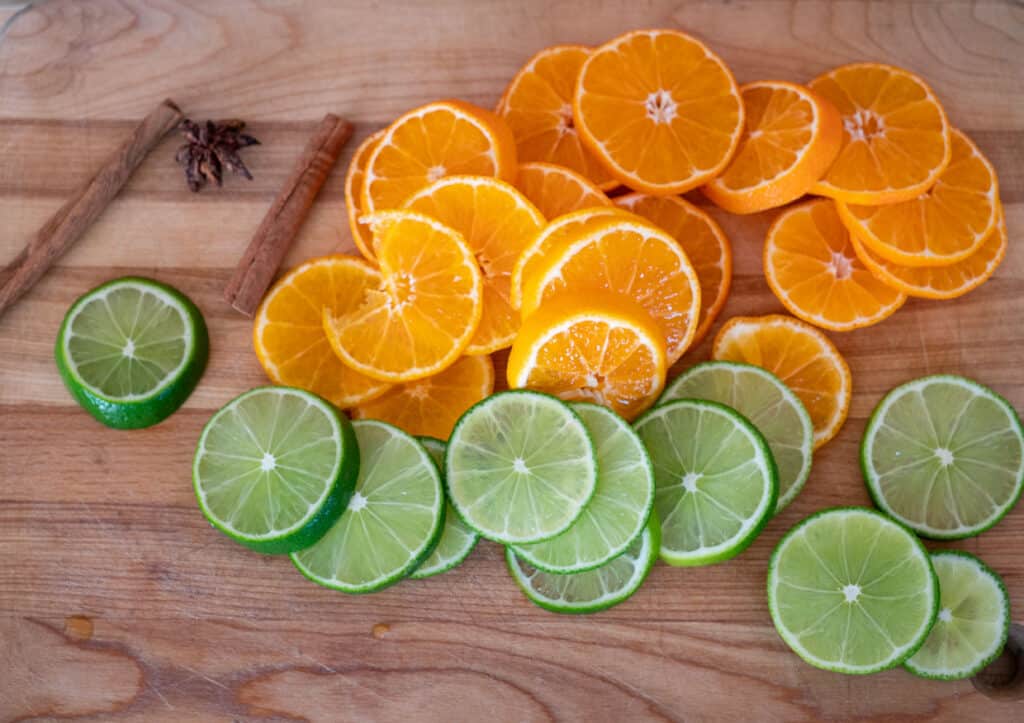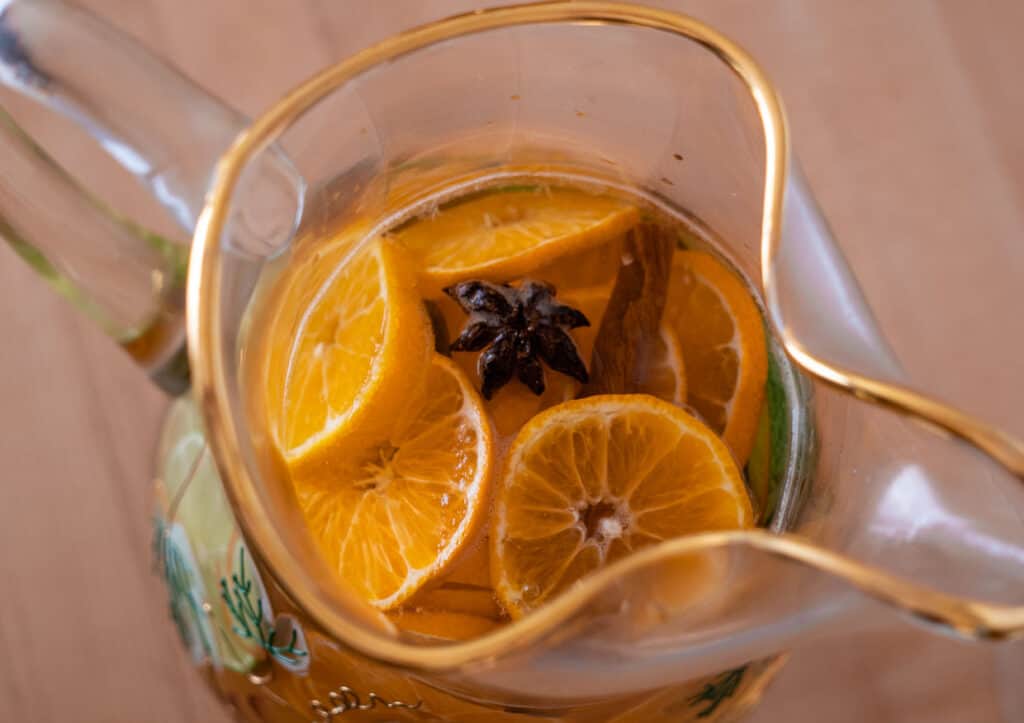Unlock the secrets to creating perfect sangria at home! Learn how to make this delicious fruity wine and impress your friends and family with your mixology skills.

Sangria is a popular Spanish drink that is like a party in a glass! It is traditionally made with red wine, fruit, and a sweetener like sugar, but you can learn how to make sangria at home and enjoy many fun variations.
Sangria is the perfect drink for gatherings with friends or any occasion that calls for a little celebration. Use this guide to learn how to make your own and add your own unique flair to this delicious beverage.
Origins of Sangria
The origins of sangria are a mystery, but it has been around for centuries, perhaps even back to ancient Rome. People love to add fruit to wine, so it’s likely that many cultures have experimented with different recipes.
Regardless of where it comes from, sangria is a delicious and versatile drink that has stood the test of time. It has become a staple of Spanish and Portuguese culture and is now loved by people worldwide.
Selecting a Base Wine
When making sangria, the first thing you have to decide is your base wine.
- Type of wine: Traditional sangria is made with red wine, but you can decide to use white wine, rosé, or champagne. Fruity wines work well for sangria because the added fruit will enhance their natural flavor. Avoid using a wine that is too dry or high in tannins. Here are some outstanding wine choices:
- Red wines – Rioja, Tempranillo, Grenache, Merlot, Shiraz
- White wines – Sauvignon Blanc, Verdejo, Riesling, Moscato
- Quality of wine: Use a good quality wine, but it doesn’t need to be an expensive bottle. Look for a wine that has good flavor at a reasonable price.
- Personal preference: In the end, the best wine for sangria is one you enjoy drinking.
Fruit Adds Flavor and Color
You can add almost any fresh fruit to sangria. But there are some that people come back to again and again.
- Citrus fruits – Oranges, lemons, and limes are classic fruits used in sangria. They add a bright, citrusy flavor to the drink.
- Berries – Berries, like strawberries, raspberries, and blackberries, are another popular choice. They add a sweet and fruity flavor and look pretty floating in the glass.
- Apples and Pears – These add a sweet flavor to the sangria and pair well with warm spices like nutmeg and cinnamon.
- Peaches – Peaches add sweetness and juiciness to the sangria. They are outstanding paired with red wines because they help balance the tannins.
Ripe, seasonal fruit will add more flavor to your sangria. Don’t use fruit that is bruised or overripe.
Using a mix of different types of fruit will add complexity and depth of flavor to your drink. Try combining different types of citrus fruit, berries, and stone fruit, like peaches, for a well-rounded drink.

Add Sweeteners
The type of wine you choose and your personal preference has a significant impact on what, if any, sweeteners are needed. Some people prefer a drier, less sweet drink, while others like a sweeter sangria.
If you start with a dry wine, you may want some sweetener to balance out the flavor. But if you start with a sweet wine, you may not need to add any.
When adding sweeteners, it is crucial to taste the drink as you go and adjust the sweetness to your liking. Here are the classic options for sweeteners.
- Sugar or Simple Syrup – Dissolve sugar in the wine or make a simple sugar syrup.
- Honey or Maple Syrup – These add both flavor and sweetness.
- Fruit juice – Use orange juice or apple juice for sweetness and fruity taste.
Add Spices
Many spices and herbs can be used to add flavor to the wine. Whole spices look prettier, but ground spices work fine too.
- Cinnamon and Nutmeg – These add a warm and spicy flavor to sangria and pair well with red wine.
- Cloves – Cloves add a warm and slightly sweet taste to sangria and go well with red wine and fruit. They are frequently combined with cinnamon.
- Star anise – Star anise adds a licorice-like flavor to sangria and pairs well with red wine and fruit. It also has a distinctive shape that looks great floating in a glass.
- Orange or Lemon peel – Citrus peel adds a bright and citrusy flavor to sangria and works with most wines. Use the outer peel since the inner white part can be bitter.
Proportions of Ingredients
The basic ingredients needed vary depending on what you like and how much sangria you make. But it is helpful to have a general guideline before starting.
- Wine – A good rule of thumb is to use about one bottle of wine for every 4-6 servings.
- Fruit – Plan on 3-5 cups of cut fruit per bottle of wine.
- Sweetener – A good starting point is to use about 1-4 tablespoons of sweetener per bottle of wine. Then taste and increase if necessary.
- Spices – Use about 1 cinnamon stick, 8 cloves, 1 star anise, or about 1/4 teaspoon of ground spices per bottle.
How To Make Sangria
- Prep the Fruit – Cut the fruit into pieces that won’t get in the way while you’re drinking. Remove the seeds of fruit like oranges and apples, but there is no need to peel the fruit.
- Combine the Ingredients – Pour the wine into a large pitcher and stir in any sweetener you use. Then add the sliced fruit and spices.
- Marinate – Generally, it is best to let sangria rest in the fridge for about 2 hours before serving. This allows the fruit to soak up the flavor of the wine. Softer fruits like berries and peaches absorb the flavors more quickly than firmer fruit like apples.
Can You Marinate Sangria Too Long?
Yes, if you let sangria sit for too long the fruit will start to break down and get mushy. The wine can also get more acidic or even bitter.
If you are using soft fruit, making sangria two to four hours before you serve it is ideal. But it will keep overnight as long as you refrigerate it.

Serving Ideas
Sangria is best served chilled, and it is meant to be shared, so use a large pitcher or a punch bowl for serving. Garnish the sangria glasses with some of the fruit used to infuse the recipe.
Here are a few serving ideas to consider:
- At a party – A pitcher of sangria is ideal for a party or an informal gathering.
- As a refreshing summer drink – Sangria is refreshing and perfect for sipping at a backyard barbecue on a hot summer day. Serve it over ice in tall glasses garnished with orange slices.
- As a dessert drink – Sangria can be served as a dessert drink, either on its own or paired with a sweet treat like chocolate.
- At a picnic or cookout – Sangria is an excellent choice because it can be made ahead of time and stored in a cooler. Just be sure to keep it chilled until it’s time to serve.
Wrapping Up
You can easily learn how to make sangria at home. It is a delicious and versatile drink that can be made with simple ingredients. Following the tips outlined in this guide, you can create a delightful and refreshing sangria everyone will love.
With a bit of creativity and many delicious ingredients, you can make the perfect sangria for any occasion. Play with the flavors and ingredients and create your own personalized sangria recipe.
Anne Jolly is the creator of the food blog Upstate Ramblings. She loves to cook with gadgets like an air fryer, sous vide or pressure cooker. In her free time she enjoys hiking, reading, knitting and spending time with her three kids.